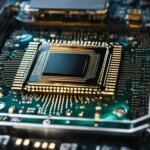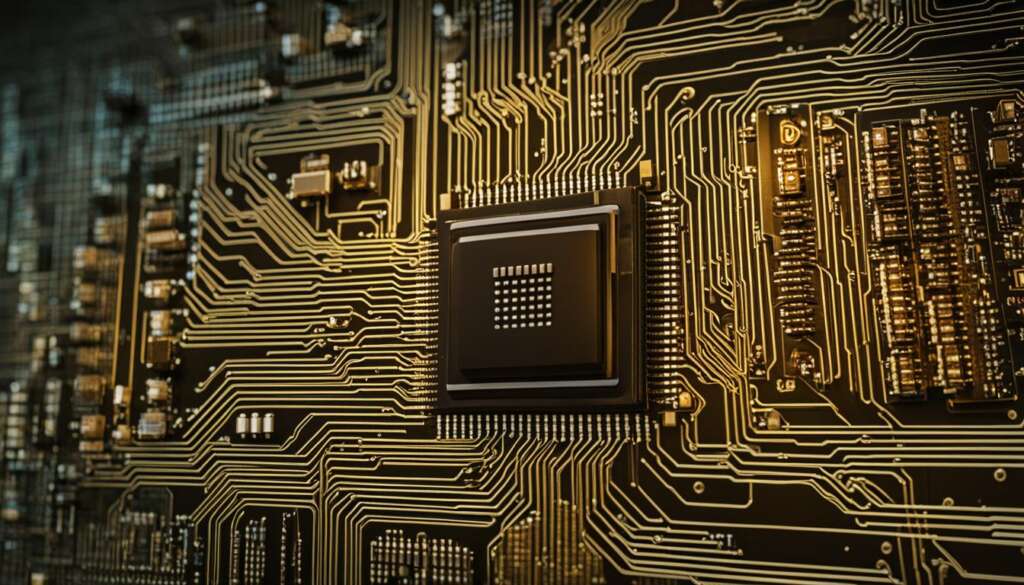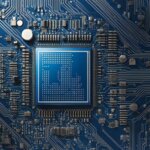Table of Contents
The story of how computer architecture has evolved is truly fascinating. It began with the large and slow vacuum tubes in the mid-20th century. Then, the introduction of transistors in the late 1940s brought significant improvements. Computers became more efficient and reliable1.
Integrated circuits came next in the 1960s and 1970s. They allowed numerous transistors to fit on a single chip. This made computers cheaper and more powerful1.
The era of microprocessors started with the Intel 4004 in the early 1970s. It marked the beginning of personal computing, bringing technology into our homes2. Now, we stand on the verge of a new shift towards quantum computing. This advanced technology aims to solve complex problems in cryptography, materials science, and drug discovery at incredible speeds3
Each stage in the evolution of computer architecture sets the stage for future breakthroughs. It reflects the technology of its time and paves the way for what’s next.
Key Takeaways
- The evolution of computer architecture progressed from vacuum tubes to microprocessors and now towards quantum computing.
- The shift from vacuum tubes to transistors greatly enhanced the efficiency of early computers.
- Integrated circuits revolutionised the computing landscape by enabling vast amounts of processing power on compact chips.
- Personal computing emerged as a significant milestone driven by the creation of microprocessors.
- Quantum computing is set to redefine computational limits, providing solutions to problems previously thought insurmountable.
- Understanding the history of computer architecture is crucial for appreciating present technologies and future developments.
- The advancements in computing not only reflect technological improvements but also impact social and economic structures globally.
Introduction to Computer Architecture
Computer architecture gives us a blueprint of how computer systems are set up and work. The term was first used in 1964 by the creators of IBM’s System/360. This laid down the basic ideas for registers, memory, and instruction sets. Knowing about this helps us understand how computers have changed over time. It shows how these changes have helped both the physical parts of computers and the programs they run.
The story of computer architecture goes through many phases. The earliest computers in the 1940s and 1950s used vacuum tubes and punch cards. These first steps helped lead to more advances4. Then came the second generation in the 1950s and 1960s. Here, transistors made computers smaller, more dependable, and much quicker4.
The introduction of integrated circuits in the 1960s and 1970s brought us even smaller and more powerful computers. The Jacquard loom of 1804 is worth noting. It used punched cards to store programs5, a big leap towards modern computing. IBM’s System/360 in the 1960s changed everything with a compatible instruction set and newer processing methods5.
These moments are key in understanding the role of computer architecture. From ENIAC, the first programmable computer, to the latest multi-core processors. Each step reflects a push towards better performance and efficiency.
Early Beginnings: The Age of Vacuum Tubes
The era of vacuum tubes started a big change in computer architecture. Early computers were huge, taking up whole rooms and using lots of energy. Size and power consumption issues with vacuum tubes appeared quickly. For example, in 1946, ENIAC used over 17,000 vacuum tubes. It needed 150 kilowatts of power, mostly for heating, not for computing. This inefficiency started the search for better technologies, showing the need for progress in computing6.
Room-Sized Behemoths and Their Limitations
The massive size of these computers limited their use. The Ferranti Mark 1 in 1951 showed what was possible but also its limits. It was innovative but slow and not efficient. This affected how well they worked6.
The IBM 650 and the Bull Gamma 3 showed some success. But by the early 1960s, they were outdated. This made way for the next generation of computers using transistors6.
Pioneers of Modern Computing: Turing and von Neumann
In this key time, Alan Turing and John von Neumann became important in computing’s beginnings. Turing’s work on algorithms and computation theory opened up the potential of electronic machines. At the same time, von Neumann’s ideas helped shape future computer designs. Together, they turned theory into practical ideas that helped tech grow7.
The Rise of Transistors and Integrated Circuits
In the late 1940s, transistors were invented, leading to big changes in electronics. They made devices more reliable and efficient. This allowed for smaller parts and better performing circuits. The first transistor was created by William Shockley, Walter Brattain, and John Bardeen at Bell Labs in 1947. It was much smaller than previous vacuum tubes.
Transistors: The Game Changer of the 1940s
Transistors made devices smaller and saved more energy. They were cheaper to produce, which helped make electronics widely available. They became key in computing, improving performance and efficiency. This change is still important today.
Integrated Circuits: A Leap Towards Miniaturisation
In 1958, Jack Kilby and Robert Noyce introduced integrated circuits (ICs). ICs combined many transistors on one chip, leading to more innovation. This made it possible to build whole systems on a single silicon piece. It meant lower costs and higher reliability. Integrated circuits are a big part of why computers are so good today. They also support Moore’s Law, which expects the number of transistors on a chip to double every two years, making computers more powerful.
| Innovator | Year | Invention |
|---|---|---|
| William Shockley, Walter Brattain, John Bardeen | 1947 | Transistor |
| Jack Kilby, Robert Noyce | 1958 | Integrated Circuit |
Transistors and integrated circuits have led to smaller devices with more complex features. They are key to the ongoing improvements in computers. They promise to make computing even more efficient and effective in the future8.
Computer Architecture Evolution: The Birth of Microprocessors
The arrival of microprocessors was a key moment in computer architecture. It changed how we use technology today. The Intel 4004 came out in March 1971. It was a big step, putting many parts into one small chip. This 4-bit microprocessor was used in calculators at first. It worked at 740 kHz speed and had 2,300 transistors91011. It could do 92,000 single-word instructions per second. It also used 4 KB of memory and 640 bytes of RAM. Its design started a big boom in personal computing devices that came after it.
The Intel 4004 and the Dawn of Personal Computing
The Intel 4004 helped make computing devices cheaper and more common. It was the first microprocessor that you could buy on its own. It started a new time where people could really get into computing910. As microprocessors got better, they could do more. They brought us new tech like pipeline architecture and virtual memory911. With each new version, computers got better. They changed how we use and interact with technology today.
Impact of Microprocessors on Consumer Technology
Microprocessors changed technology for all of us. They made computers cheaper and more powerful. Thanks to them, we have personal computers, game consoles, and portable gadgets that we use every day910. Microprocessors changed how we live and work. They moved us from big, bulky computers to the small, handy devices we have now. They made modern technology possible and easy to use for everyone.
| Microprocessor Model | Year Introduced | Clock Speed | Transistor Count | Instructions Per Second |
|---|---|---|---|---|
| Intel 4004 | 1971 | 740 kHz | 2,300 | 92,000 |
| Intel 80286 | 1982 | 8 MHz | 134,000 | 4 million |
| Intel 80486 | 1986 | 16 – 100 MHz | 1.2 million | N/A |
| Intel Core 2 | 2006 | 1.2 – 3 GHz | 291 million | N/A |
Transitioning Through the Computing Ages
The jump from early computing to the advanced PCs of the ’80s and ’90s was huge. With the advent of personal computers, everyone’s interaction with technology changed. Suddenly, computing was within reach for more people, enriching their everyday lives.
The Impact of Personal Computers in the 1980s and 1990s
When the 1980s began, brands like Apple, IBM, and Commodore led the charge into personal computing. Their user-friendly interfaces sparked a boom in PC ownership. People at home and work started using computers for everything from typing documents to complex tasks.
This new ease of use let everyone exploit computing power. It removed the barrier that kept tech in the hands of experts alone.
Networking and the Internet Age: New Challenges and Solutions
The late 20th century brought the internet, reshaping how computers connect and communicate. This era posed new data processing challenges. Computers had to handle more information and navigate busier networks.
To tackle this, network designs improved, and protocols were developed for stable, secure connections. Experts turned to parallel computing and distributed systems. These became key for managing data smoothly and upholding network performance.
| Decade | Key Developments | Impact on Society |
|---|---|---|
| 1980s | Rise of personal computers | Democratisation of technology, making computing accessible |
| 1990s | Growth of the internet | Revolutionised communication, commerce, and data processing |
| 1990s | Networking advancements | Enabled better connectivity and data sharing |
Contemporary Advancements: AI and Quantum Computing
As we move through the 21st century, artificial intelligence is changing how computers are built. There’s a growing need for hardware that’s made just for AI tasks. These tasks include deep learning and working with neural networks14. This need leads to new inventions that make computers better. They help solve problems that AI faces today, like working with big, complex data with the computers we currently have.
The Role of AI in Shaping Future Architectures
AI is evolving fast, thanks to machine learning and deep learning. These technologies enable systems to make decisions on their own by learning from large amounts of data15. While there are still challenges with current systems, AI is key in making future computers more efficient and powerful. As we need more from our computers, AI’s influence in creating new technology is becoming more important.
Exploring Quantum Computers and Their Potential
Quantum computing is an exciting area still in its early stages. It uses quantum mechanics to do tasks that regular computers can’t. Quantum computers use qubits that can be in more than one state at a time. This lets them process information in new ways through superposition15. Quantum entanglement also plays a part, letting qubits affect each other instantly. This can speed up computing and help solve tough problems in areas like security and medicine15.
There are still issues to work out with quantum computing, like making qubits more stable and reducing errors. These computers also need special conditions to work best. But, if quantum computing and AI can work together, it could lead to big breakthroughs. This combination could be great for analyzing large amounts of data. It’s especially promising for healthcare, where it could lead to better, personalised treatments. Quantum Neural Networks (QNNs) could even outdo traditional networks by learning faster and handling complex data more efficiently15.
| Aspect | Artificial Intelligence | Quantum Computing |
|---|---|---|
| Current Development Stage | Mature with practical applications | Emerging with theoretical frameworks |
| Processing Model | Classical computing architecture | Quantum mechanics principles |
| Challenges | Data scale and complexity | Qubit stability and error rates |
| Integration Potential | High with classical improvements | Possible transformative synergies |
| Impact Sector | Healthcare, finance, automotive | Cryptography, drug discovery, climate modelling |
In conclusion, AI and quantum computing together could change the future of computer architecture in amazing ways. By joining these two areas of study, we’re on our way to new computing breakthroughs. These advancements will push technology forward in ways we’ve not yet imagined14.
Conclusion
The story of computer architecture’s evolution is nothing short of amazing. It started with simple electronic computers in the 1940s. Now, we’re exploring the edges of quantum computing. Key innovations like transistors and integrated circuits have changed how we interact with technology. They show the relentless push for new ideas that marks this field. Today, we’re seeing advances in multicore processors and growing interest in quantum computing. These developments promise more powerful and accessible computing futures.
Looking forward, the possibilities in computer architecture seem endless. There’s a strong drive to make systems faster and more efficient. This pushes experts to find solutions that break current limits and set new performance high-points. The impact of computer architecture on several areas highlights its importance. We rely on these advances to improve our day-to-day lives.
Computer architecture’s journey is a clear show of human creativity. Every new step brings us closer to unknown potentials and new questions. This progress is set to motivate many future generations. For a deeper understanding of these important advances, check out this resource. It offers great insights into how technology evolves and impacts us16.
FAQ
What is computer architecture?
Computer architecture shapes the blueprint of computer systems. It focuses on registers, memory, and instructions. Understanding it helps grasp key advancements and ensures software and hardware cooperate well.
How did vacuum tubes impact early computer development?
Vacuum tubes were the heart of early computers. They were big, ate a lot of power, and weren’t very efficient. Even so, they set the stage for the tech leaps that followed.
What role did Alan Turing and John von Neumann play in computing?
Alan Turing and John von Neumann were computing trailblazers. Turing’s algorithms and computation theories meshed with von Neumann’s practical strategies. Together, they laid the groundwork that has driven computer science forward.
What are transistors, and why are they significant?
Transistors came about in the late 1940s, changing everything. They made computers more reliable and compact than the old vacuum tube systems. Suddenly, building complicated circuits got a lot easier, leading to big tech advances.
How did integrated circuits change computing technology?
In 1958, Jack Kilby and Robert Noyce introduced integrated circuits. They shrunk electronic parts down to fit on a silicon chip. This cut costs, boosted production, and supercharged computers.
What impact did the Intel 4004 have on personal computing?
The Intel 4004, the first microprocessor, arrived in the 1970s. It bundled key computing functions on a single chip. This kicked off the era of personal computing, changing how we use technology daily.
How did personal computers evolve during the 1980s and 1990s?
Through the 1980s and 1990s, microprocessors soared, making personal computers common. Computers became a staple of daily life. They set the foundation for the IT explosion that was to come.
What challenges did the internet age present to computer architecture?
The rise of the internet brought challenges in processing and connecting massive data. Innovations in parallel computing and networks emerged. They tackled these issues, pushing computing ahead.
How is artificial intelligence influencing the future of computer architecture?
Artificial intelligence is reshaping computer designs. It demands hardware that specialties in deep learning. This shows how computer architecture evolves with technology’s needs.
What potential does quantum computing hold for the future?
Quantum computing could revolutionize how we approach problems. It aims to massively speed up calculations using quantum mechanics. This could unlock new achievements in many fields.
Source Links
- https://dev.to/akashdev23/the-evolution-of-computing-from-vacuum-tubes-to-microprocessors-5cpb – The Evolution of Computing: From Vacuum Tubes to Microprocessors
- https://perfectelearning.com/blog/from-eniac-to-quantum-computing-unveiling-the-computer-generations – From ENIAC to Quantum Computing: Unveiling the Computer | Perfect eLearning
- https://medium.com/@a86058398/the-evolution-of-computer-architecture-a9053b9b6bd4 – The Evolution of Computer Architecture
- https://medium.com/@chandrasyah999/understanding-computer-architecture-a-comprehensive-overview-63a84543f8d5 – Understanding Computer Architecture: A Comprehensive Overview
- https://www.sigarch.org/a-brief-and-biased-history-of-computer-architecture-part-1/ – A Brief and Biased History of Computer Architecture (Part 1)
- https://en.wikipedia.org/wiki/Vacuum-tube_computer – Vacuum-tube computer
- https://www.livescience.com/20718-computer-history.html – History of computers: A brief timeline
- https://quantumzeitgeist.com/a-brief-history-of-the-transistor-and-integrated-circuit/ – A Brief History Of The Transistor And Integrated Circuit
- https://www.sjsu.edu/people/robert.chun/courses/CS247/s4/M.pdf – Proceedings Template – WORD
- https://www.geeksforgeeks.org/evolution-of-microprocessors/ – Evolution of Microprocessors – GeeksforGeeks
- https://engineering.stanford.edu/magazine/ted-hoff-birth-microprocessor-and-beyond – Ted Hoff: the birth of the microprocessor and beyond
- https://pcsite.medium.com/tracing-the-evolution-of-computers-through-the-years-8466940dc3fc – Tracing the Evolution of Computers Through the Years
- https://web.itu.edu.tr/~gerzeli/History.htm – A Brief History of Computer Technology
- https://www.linkedin.com/pulse/what-evolution-computers-since-inception-how-does-timeline-corbeel-8ijxe – What is the evolution of computers since their inception, how does this timeline lend itself as a trajectory towards the future of computing?
- https://marshallstanton.com/quantum-intelligence-navigating-the-ai-evolution-d9692e17eebd – Quantum Intelligence: Navigating the AI Evolution
- https://www.rroij.com/open-access/exploring-the-evolution-and-recent-trends-in-computer-architecture.pdf – PDF








